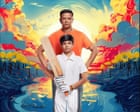INDIGO
Ella Summer writes for an occult publication called Mars, covering urban legends, reptilian conspiracy theories, and other stories for which there is no proof. (As her editor likes to tell his reporters, “To have proof is called science, not the occult!”) When one of Ella’s former university professors dies mysteriously of apparent starvation, she drops what she’s working on to investigate. Professor Wilhelm was conducting research on humanity’s origins that challenged the theory of evolution, and he shared a special quality with Ella: the ability to communicate telepathically with plants and animals. Could this ability have any connection to the suspicious circumstances of his death? Her investigation soon draws the attention of certain men dressed in black, who apparently visited Wilhelm shortly before his death; Ella’s editor warns her off the case, protesting that it’s too dangerous. With the help of her co-worker Gene, Ella presses on and discovers the professor’s notebook, which is filled with information about so-called Indigo Children—aliens sent from distant stars to help Earth in some unknown way whose inability to adapt to the planet often makes them depressed or even suicidal. Could the professor have been one of these Indigo Children? Could Ella? And if she is, how is she meant to save the world—and would she even want to? The book’s standout feature is the truly transportive illustration work of Chi-Kit Kwong, which is both richly textured and filled with arresting, memorable imagery. Some of the author’s sentences are slightly awkward (case in point: “To have proof is called science”), but the story is engaging and filled with fun twists, particularly once the outlandish conspiracy theories of the magazine begin to overlap with Ella’s quest to understand the professor’s death. Despite the nods to contemporary urban legends, this world feels entirely original, and it’s one that readers will want to return to after the volume ends.


Ella Summer writes for an occult publication called Mars, covering urban legends, reptilian conspiracy theories, and other stories for which there is no proof. (As her editor likes to tell his reporters, “To have proof is called science, not the occult!”) When one of Ella’s former university professors dies mysteriously of apparent starvation, she drops what she’s working on to investigate. Professor Wilhelm was conducting research on humanity’s origins that challenged the theory of evolution, and he shared a special quality with Ella: the ability to communicate telepathically with plants and animals. Could this ability have any connection to the suspicious circumstances of his death? Her investigation soon draws the attention of certain men dressed in black, who apparently visited Wilhelm shortly before his death; Ella’s editor warns her off the case, protesting that it’s too dangerous. With the help of her co-worker Gene, Ella presses on and discovers the professor’s notebook, which is filled with information about so-called Indigo Children—aliens sent from distant stars to help Earth in some unknown way whose inability to adapt to the planet often makes them depressed or even suicidal. Could the professor have been one of these Indigo Children? Could Ella? And if she is, how is she meant to save the world—and would she even want to? The book’s standout feature is the truly transportive illustration work of Chi-Kit Kwong, which is both richly textured and filled with arresting, memorable imagery. Some of the author’s sentences are slightly awkward (case in point: “To have proof is called science”), but the story is engaging and filled with fun twists, particularly once the outlandish conspiracy theories of the magazine begin to overlap with Ella’s quest to understand the professor’s death. Despite the nods to contemporary urban legends, this world feels entirely original, and it’s one that readers will want to return to after the volume ends.


























![Brand and SEO Sitting on a Tree: K-I-S-S-I-N-G [Mozcon 2025 Speaker Series]](https://moz.com/images/blog/banners/Mozcon2025_SpeakerBlogHeader_1180x400_LidiaInfante_London.png?auto=compress,format&fit=crop&dm=1749465874&s=56275e60eb1f4363767c42d318c4ef4a#)

![How To Launch, Grow, and Scale a Community That Supports Your Brand [MozCon 2025 Speaker Series]](https://moz.com/images/blog/banners/Mozcon2025_SpeakerBlogHeader_1180x400_Areej-abuali_London.png?auto=compress,format&fit=crop&dm=1747732165&s=beb7825c980a8c74f9a756ec91c8d68b#)
![Clicks Don’t Pay the Bills: Use This Audit Framework To Prove Content Revenue [Mozcon 2025 Speaker Series]](https://moz.com/images/blog/banners/Mozcon2025_SpeakerBlogHeader_1180x400_Hellen_London.png?auto=compress,format&fit=crop&dm=1747758249&s=9f3c5b1b7421f862beace1cb513053bb#)























![The 11 Best Landing Page Builder Software Tools [2025]](https://www.growthmarketingpro.com/wp-content/uploads/2024/04/best-landing-page-software-hero-image-1024x618.png?#)


































![How To Build AI Tools To Automate Your SEO Workflows [MozCon 2025 Speaker Series]](https://moz.com/images/blog/banners/Mozcon2025_SpeakerBlogHeader_1180x400_Andrew_London-1.png?auto=compress,format&fit=crop&dm=1749642474&s=7897686f91f4e22a1f5191ea07414026#)














![Marketers Using AI Publish 42% More Content [+ New Research Report]](https://ahrefs.com/blog/wp-content/uploads/2025/06/marketers-using-ai-publish-42-more-by-ryan-law-data-studies-1.jpg)














![Social media image sizes for all networks [June 2025]](https://blog.hootsuite.com/wp-content/uploads/2023/01/Social-Media-Image-Sizes-2023.png)


![The HubSpot Blog’s AI Trends for Marketers Report [key findings from 1,000+ marketing pros]](https://www.hubspot.com/hubfs/state-of-AI-1-20240626-53394.webp)
![AI can boost conversions from your web page — HubSpot’s CMO shows you how [tutorial]](https://knowledge.hubspot.com/hubfs/ai-1-20250605-395473.webp)
![The state of inclusive marketing in 2025 [new data + expert insight]](https://www.hubspot.com/hubfs/inclusive-marketing-report.webp)



















